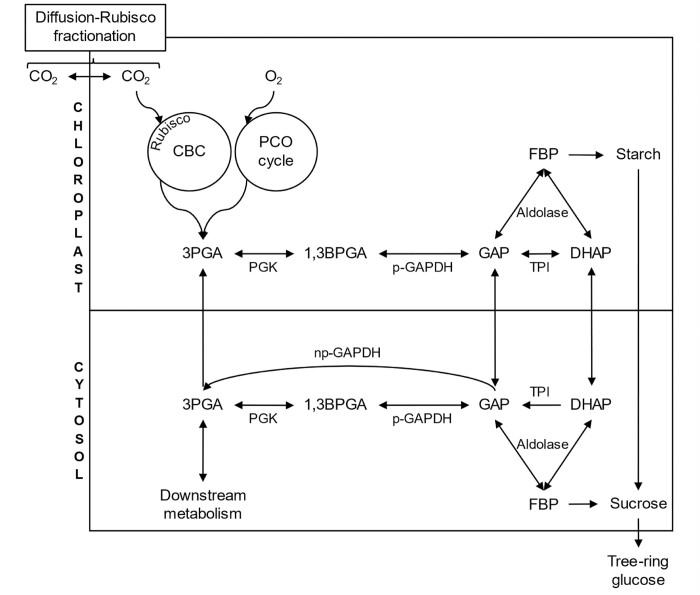Fig. 1.
Carbon metabolism in plant leaves. In our 13C discrimination model, cytosolic GAP has two fates: (i) glycolytic 3PGA and downstream metabolism, and (ii) FBP and downstream metabolism including the biosynthesis of tree-ring glucose (Fig. 4). Forward conversion of GAP to 3PGA can proceed via either non-reversible np-GAPDH or reversible p-GAPDH and PGK, while the reverse conversion of 3PGA to GAP relies on PGK and p-GAPDH. Both the commitment of GAP to 3PGA versus FBP metabolism and the contribution of np-GAPDH versus p-GAPDH to catalysing the GAP to 3PGA forward conversion may alter the 13C/12C ratio at tree-ring glucose C-4 and respond to environmental cues. In vivo, the reaction catalysed by cytosolic TPI is strongly displaced from equilibrium on the side of GAP (Wieloch et al., 2021, Preprint). That is, GAP and DHAP are not in isotopic equilibrium because cytosolic flux from GAP to DHAP is negligible. Parts of the PCO cycle reside outside chloroplasts, in peroxisomes, and mitochondria. Figure 2 shows the depicted reactions in detail. Abbreviations: 1,3BPGA, 1,3-bisphosphoglycerate; 3PGA, 3-phosphoglycerate; Aldolase, fructose-bisphosphate aldolase; CBC, Calvin–Benson cycle; DHAP, dihydroxyacetone phosphate; FBP, fructose 1,6-bisphosphate; GAP, glyceraldehyde 3-phosphate; np-GAPDH, non-phosphorylating glyceraldehyde-3-phosphate dehydrogenase; PCO cycle, photosynthetic carbon oxidation (photorespiration) cycle; p-GAPDH, phosphorylating glyceraldehyde-3-phosphate dehydrogenase; PGK, phosphoglycerate kinase; TPI, triose-phosphate isomerase.

